 The volcano Lascar, one of Chile´s most active, erupted yesterday after six years of silence (left). A loud explosion shook the surroundings, including the small village of Talabre with 12 families who live in the proximity of the mountain. Three eruptions followed, with decreasing intensity and left a 3000 meter high pillar of smoke and ashes. An area within 30 kms from the site was left with an unpleasant smell of sulfur.
The volcano Lascar, one of Chile´s most active, erupted yesterday after six years of silence (left). A loud explosion shook the surroundings, including the small village of Talabre with 12 families who live in the proximity of the mountain. Three eruptions followed, with decreasing intensity and left a 3000 meter high pillar of smoke and ashes. An area within 30 kms from the site was left with an unpleasant smell of sulfur.Lascar erupts by average every 5.8 years since 1848, and it´s largest recorded outburst was in April of 1993 (right, below). At that occasion, ashes reached 22 kms of altitude and all the way to Buenos Aires, some 1500 kms away. The total amount of erupted
 materials was estimated to 0,1 km3.
materials was estimated to 0,1 km3.Now why am I so interested in this volcano, you might ask?
It´s because I climbed it in November 2004. Let me tell you about this experience.
On the morning of the first day, me and my fellow adventurer Beat Baumgartner (a swiss) were picked up by the guide in his 4x4. We left the tranquil commodity of San Pedro de Atacama and headed for the high plateau, or altiplano. After travelling a while on well-kept, paved road we tu
 rned off and began to close in on our target. An epic scenery opened up with infinite, life-denying deserts to the sides and towering volcanic peaks confronting us. On the slopes we could spot shepherds grazing their llamas. We also passed Old Talabre, a village which was abandoned when Lascar threatened it´s people a decade ago.
rned off and began to close in on our target. An epic scenery opened up with infinite, life-denying deserts to the sides and towering volcanic peaks confronting us. On the slopes we could spot shepherds grazing their llamas. We also passed Old Talabre, a village which was abandoned when Lascar threatened it´s people a decade ago.We were headed to a canyon at the foot of the volcano which offered a suitable spot for raising a tent. It is important to give your body time to adapt to the altitude, and our guide had recommended us to do a two-day ascent. By spending a night on the altiplano your lungs learn to collect more oxygen from every breath and the final climb goes much smoother.

We raised our shelter, or rather the guide did; me and Beat just chilled, after all, we were paying this guy. After that we took an evening stroll to let us acclimatize more rapidly. We reached 3500 m, sat down and enjoyed our raisin-and-peanut-snack. This wasn´t so bad, I thought. The sun would soon set so we began to return to base. The temperature may drop rapidly since the atmosphere is thinner here. Indeed it did. When the sun was setting it became freezing cold, and my bowels did not feel OK. You see, the air which you carry inside your body expands when you go higher. So, you can imagine the discomfort. I returned quickly to the tent and refused to eat anything, hoping to keep everything "in-house".
After an incredibly cold night, morning came. It was also incredibly cold. Rapidly we deassembled our camp, or rather the guide did, and began the drive to where we would start the climb. On the way, we stopped at a lagoon for breakfast. On the menu was bread and jelly and chocolate cookies. We needed fast energy.
As far as our vehicle would take us we drove, stopping only at the wall which undisputably said "Volcano Starts Here". We were located at 4 700 m, and the guide estimated it would take us four hours to reach the crater by foot.
As we were going up my muscles became increasingly weaker and I seemed to be out of breath no matter how slowly I proceeded. Our feet stepped in volcanic gravel, there was no ice or snow on this side. The sky was completely clean-swept and if you managed to look over your shoulder, a breath taking view was awarded to you. But there was no time for sight seeing, the goal was up, up, up. It is just too exhausting to be looking around, all your energy must go into your legs.

Of course we made breaks, which I spent in horizontal mode (left, with guide). Annoyingly, the swiss didn´t seem affected at all by the altitude and strolled freely up and down the inclination.
He was also the first to reach the topside, with me and the guide following just behind.
A sensation of accomplishment, conquest and relief flowed through my aching body. It was all worth it. We were standing at 5 500 m above sea level, on the crater rim of one of Chile´s most active volcanoes. The last eruption had occurred in the year 2000, it could come again at any moment. But we were not concerned, and enjoyed the amazing view. We could see the peaks of the mountain range fade away in the horizon, glimpsing Llullaillaco, a volcano more than 150 kms away. In general, the view reminded more of what you would see from an airplane cabin than anything else. In spite of the severe dizzyness I was experiencing, I managed to take some pictures... or rather the guide did.

1 comment:
Gabriel, I enjoyed the climbing chronicle quite a lot! Now then when we meet soon we can concentrate on some others of your adventurous exploits.
Your (rather envious) Dad
Post a Comment